When I set out to upgrade my bedroom, I wanted a bed frame that was stylish, sturdy, and sustainable. After scrolling through countless options, I narrowed it down to two contenders: Thuma and Tatami Room.
Both brands promise minimalist designs, eco-friendly materials, and easy assembly, but which one truly delivers? In this article, I’ll share my experience comparing these platform beds, weighing their pros and cons, and breaking down their key features to help you decide which one fits your sleep sanctuary.
Let’s find out which frame reigns supreme for your bedroom dreams.
A Brief Comparison Table
| Feature | Thuma | Tatami Room |
| Price (Queen) | $1,095–$1,795 (with headboard) | $839–$849 (regular or tall) |
| Material | Upcycled rubberwood | Solid rubberwood |
| Assembly | Tool-free, Japanese joinery | Tool-free, Japanese joinery |
| Warranty | Lifetime | 5 years |
| Shipping | Free, 6–14 days | Free, 6–10 weeks |
| Weight Capacity | 1,500 lbs | Not specified (highly sturdy) |
| Height Options | 13″ (standard) | 4″ (regular), 10″ (tall) |
| Headboard Options | PillowBoard or wooden headboard | Optional wooden headboard |
| Sustainability | Greenguard Gold Certified | Limited eco-info |
| Color Options | Walnut, Natural, Espresso | Honey Oak, Natural, Walnut Brown |
| Aesthetic | Modern minimalist | Japanese-inspired, versatile |
This table sets the stage, but the real story lies in my hands-on experience. Let’s break it down.
My Quest For The Perfect Bed Frame
Moving into a new apartment last year, I was determined to create a bedroom that felt like a retreat. My old IKEA frame had served its purpose, but it creaked like a haunted house and fell apart during my last move.
I wanted something durable, easy to assemble, and good-looking enough to make my Instagram-obsessed friends jealous.
Thuma and Tatami Room kept popping up in my research, both boasting Japanese-inspired designs and tool-free assembly. I decided to test the waters, ordering a Thuma bed in walnut and a Tatami Room Tall Wakayama in honey oak to compare them side by side.
Thuma: The Sleek Minimalist Dream
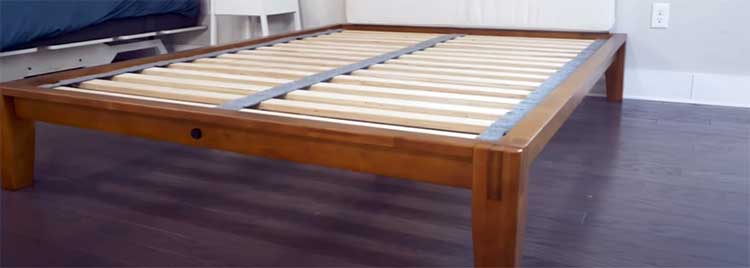
Thuma’s bed, simply called “The Bed,” is a social media darling. You’ve probably seen it on Instagram, with its clean lines and cushioned PillowBoard. I was drawn to its promise of no-tools assembly and eco-friendly credentials.
When the boxes arrived, I was impressed by how compact they were—three slim packages that didn’t require a bodybuilder to haul upstairs.
Key Features of Thuma
- Japanese Joinery: The frame uses interlocking wooden pieces, secured with just two hand-tightened screws. I had it assembled in 23 minutes, and I’m no carpenter.
- Eco-Friendly Materials: Made from upcycled rubberwood, it’s Greenguard Gold Certified, meaning low chemical emissions. I didn’t notice any off-gassing smells, which was a relief.
- PillowBoard or Headboard: The PillowBoard (a cushioned headboard) comes in charcoal, grey, or linen, while the wooden headboard matches the frame. I went with the PillowBoard in linen for a cozy vibe.
- Sturdy Design: Rated for 1,500 pounds, this bed didn’t budge when I flopped onto it after a long day. My 100-pound mattress and I (plus my cat) felt secure.
- Lifetime Warranty: Thuma’s confidence in its durability is backed by a lifetime warranty, which gave me peace of mind.
Pros of Thuma
The assembly was a breeze. I laid out the pieces, followed the clear instructions, and felt like a furniture-building pro. The walnut finish looked rich and warm, complementing my bedroom’s neutral tones.
The bed’s silence was a game-changer—no creaks, even when I tossed and turned. The 13-inch height was perfect for under-bed storage, and my robot vacuum slid underneath with ease.
Thuma’s sustainability focus also won me over; knowing the wood was repurposed made me feel like I was doing my part for the planet. Free shipping and a 100-night trial sealed the deal.
Cons of Thuma
The price tag stung. At $1,095 for a queen without a headboard, it’s a splurge. Adding the PillowBoard or headboard pushes it to $1,795, which felt excessive for rubberwood, even if it’s high-quality.
The PillowBoard, while comfy, isn’t attached to the frame, so it shifted slightly when I leaned against it. I also noticed the wood scratched easily when I accidentally bumped it with a suitcase.
Lastly, while the natural finish was beautiful, some reviews mentioned an orange hue in the walnut, which I luckily avoided.
Tatami Room: The Japanese-Inspired Contender
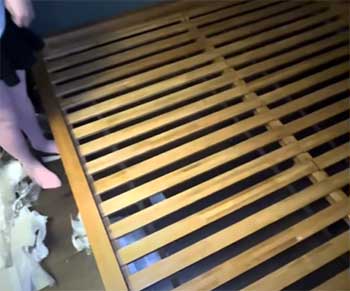
Tatami Room’s beds, particularly the Tall Wakayama, caught my eye for their understated elegance and lower price point.
I ordered the honey oak finish, hoping it would bring a light, airy feel to my space.
The wait was the first hurdle—six weeks compared to Thuma’s one-week delivery—but when it arrived, I was eager to see how it stacked up.
Key Features of Tatami Room
- Solid Wood Construction: Like Thuma, it uses rubberwood, but Tatami Room emphasizes full-length lumber over scraps. The frame felt hefty and solid.
- Tool-Free Assembly: The Japanese joinery was similar to Thuma’s, with interlocking pieces. It took me about 30 minutes to assemble, slightly longer due to the weight of the pieces.
- Height Options: The regular platform is 4 inches high, while the tall version is 10 inches. I chose the tall for easier access and storage.
- Aesthetic Versatility: Available in honey oak, natural, or walnut brown, the Wakayama’s square legs and recessed mattress design gave it a modern yet traditional look.
- Headboard Option: The optional wooden headboard is sturdy and attaches securely, unlike Thuma’s floating PillowBoard.
Pros of Tatami Room
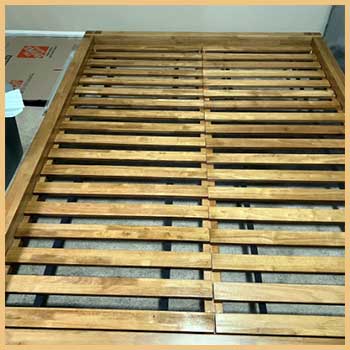
The price was a major win—$849 for a queen-sized tall platform felt like a steal compared to Thuma.
The honey oak finish was lighter than expected, adding a bright, natural vibe to my room.
The frame was rock-solid, with no wobble even when I sat on the edge.
I loved the 2-inch mattress recess, which kept my mattress from sliding, a problem I’d had with cheaper frames.
The craftsmanship was evident, with smooth slats and a 2-inch slat gap that met my mattress warranty requirements.
Customer service was also a highlight; when I emailed about delivery, Pin responded promptly and helpfully.
Cons of Tatami Room
The long lead time was a pain. Waiting six weeks meant my mattress sat on the floor longer than I’d hoped. Unlike Thuma, Tatami Room doesn’t advertise its sustainability credentials, so I was left wondering about its environmental impact.
The five-year warranty pales in comparison to Thuma’s lifetime guarantee. Some users reported a varnish smell with darker finishes, though my honey oak frame had no noticeable odor.
The slats in my order were a different shade (honey oak instead of natural), which was a minor mix-up but noticeable in certain lighting.
Key Differences Between Thuma And Tatami Room
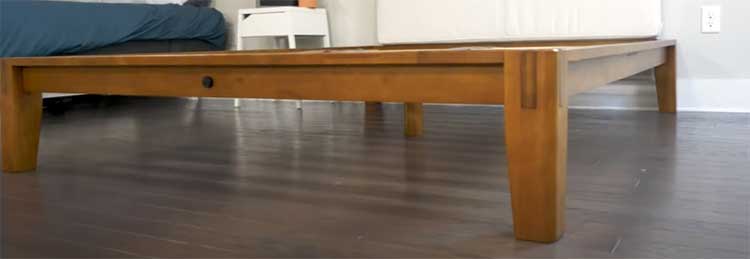
- Durability and Longevity
Durability was a top priority for me. Thuma’s 1,500-pound weight capacity and lifetime warranty gave it an edge. I tested it with my partner and cat jumping on the bed—no creaks or wobbles.
The rubberwood, while technically a hardwood, is softer than oak or maple, so I was careful about scratches. Tatami Room’s frame felt equally sturdy, with users reporting no issues after years of use.
However, the lack of a specified weight capacity and shorter warranty made me question its long-term reliability. Both beds use Japanese joinery, which eliminates metal hardware and reduces the risk of loosening over time.
- Aesthetic and Room Fit
Thuma’s sleek, modern look fit my minimalist aesthetic perfectly. The rounded leg edges were a thoughtful touch, saving my shins from bruises. The PillowBoard added a cozy vibe, though I wished it was more secure.
Tatami Room’s Wakayama leaned into a Japanese-inspired aesthetic, with square legs and clean lines that felt both traditional and contemporary. The recessed mattress design gave it a polished look, like the bed was hugging the mattress.
I found Tatami Room’s honey oak brighter and more versatile than Thuma’s walnut, which could appear orange in some lighting.
- Assembly and Moving Experience
Both beds were a dream to assemble compared to my old IKEA nightmare. Thuma’s process was slightly faster, taking 23 minutes versus Tatami Room’s 30. The instructions for both were clear, and no tools were needed, which was a relief for someone like me who misplaces screwdrivers. Moving was where Thuma shone.
I disassembled it in minutes, bundled it up, and reassembled it in my new place without a hitch. Tatami Room’s heavier pieces made disassembly trickier, and I needed a friend to help align the corners.
If you move often, Thuma’s portability is a big plus.
- Sustainability and Materials
Thuma’s eco-credentials were a standout. The upcycled rubberwood and Greenguard Gold Certification reassured me that I was making a responsible choice. Tatami Room’s use of solid rubberwood was solid but lacked the same transparency about sourcing or emissions.
I reached out to Tatami Room, and while Pin confirmed the wood was from Indonesia, there was no mention of certifications. If sustainability is a priority, Thuma has the upper hand.
- Price and Value
Thuma’s $1,095 starting price for a queen felt steep, especially when the headboard pushed it to $1,795. Tatami Room’s $849 price tag was more wallet-friendly, and the quality didn’t feel compromised.
However, Thuma’s lifetime warranty and faster shipping added value for me. If budget is your main concern, Tatami Room offers similar quality for less, but you’ll need patience for the lead time.
- Silk & Snow Comparison
I also considered Silk & Snow’s wooden bed frame, priced at $850 for a queen. It uses solid acacia wood and tool-free joinery, much like Thuma and Tatami Room. However, its aesthetic leans toward soft fabrics, which didn’t match my minimalist vibe.
Silk & Snow’s five-year warranty and 30-night trial are less generous than Thuma’s, and some users noted the frame’s finish felt less premium. For me, Silk & Snow was a strong contender but didn’t outshine Thuma’s durability or Tatami Room’s price.
Real-User Insights from Online Communities
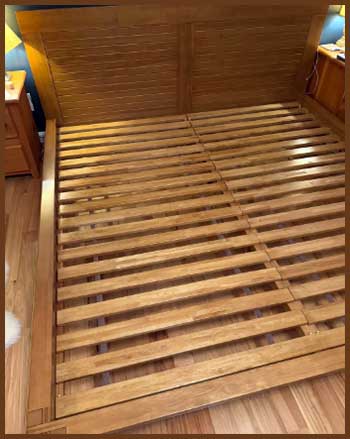
I scoured Reddit and forums like Mattress Underground to see what others thought.
Thuma users raved about its sturdiness and ease of assembly, with many saying it survived multiple moves without a scratch.
Some complained about the price and PillowBoard’s lack of attachment.
Tatami Room owners loved the Wakayama’s design and affordability, though the long wait was a common gripe.
One user mentioned their Tatami frame held up for three years without issues, while another praised Thuma’s customer service for replacing a scratched slat promptly.
My Experience With Tatami Mats
Curious about traditional tatami mats, I tested them on both frames. Thuma’s slats worked fine with a futon, but the mats slid slightly without extra grip. Tatami Room’s recessed design held the mats better, creating a seamless Japanese-style setup.
However, tatami mats require maintenance—regular airing to prevent mold and careful cleaning to avoid stains. For a Western mattress, both frames performed equally well, but Tatami Room’s recess gave it a slight edge for stability.
Making My Choice
After weeks of testing, I leaned toward Thuma for its durability, eco-credentials, and faster shipping. The lifetime warranty and silent design were hard to beat, even if the price made me wince.
Tatami Room’s affordability and unique aesthetic were tempting, especially for a Japanese-inspired setup, but the wait time and shorter warranty tipped the scales. Your choice depends on your priorities—budget and patience favor Tatami Room, while durability and speed point to Thuma.
Frequently Asked Questions (FAQ)
Tatami Room beds have long lead times (6–10 weeks), a shorter five-year warranty, and limited sustainability info. Some users report a varnish smell with darker finishes, and the heavier frame can be harder to move.
With proper care, Thuma’s bed can last decades, backed by a lifetime warranty. Its solid rubberwood and Japanese joinery ensure durability, though scratches are possible with rough handling.
No, Thuma beds are designed to be squeak-free, thanks to their Japanese joinery and lack of metal hardware. I experienced no noise during use.
Silk & Snow is more affordable ($850 vs. $1,095 for a queen) and uses acacia wood, but Thuma’s lifetime warranty, faster shipping, and Greenguard certification give it an edge. Silk & Snow’s fabric aesthetic may not suit everyone.
Wrapping Up
You’ve got a big decision ahead, and I hope my journey comparing Thuma and Tatami Room helps you find the perfect bed frame. Thuma’s sleek design, eco-friendly materials, and lifetime warranty make it a premium choice if you can stomach the cost.
Tatami Room offers incredible value and a traditional aesthetic, but you’ll need to plan for the wait. Weigh your budget, style, and timeline, and you’ll land on the bed frame that makes your bedroom feel like home. Sweet dreams!

Great research. Thanks for your work. We are evaluating these two choices and one other in an American made bedroom pencil post set by Vaughn-Bassett that is just a bit cheaper than Thuma and is incredibly sturdy.